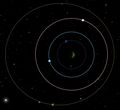Difference between revisions of "Jool"
(→Natural Satellites) |
(→Atmosphere) |
||
| Line 36: | Line 36: | ||
[[File:JoolAtmosphere.png|thumb|right|Aerobraking in Jool's atmosphere.]] | [[File:JoolAtmosphere.png|thumb|right|Aerobraking in Jool's atmosphere.]] | ||
| − | Although Jool has a radius ten times greater than [[Kerbin]], its atmosphere begins approximately twice as high (138.2 km). It is also extremely dense, well suited for aerobraking from a high-speed inter-planetary intercept. | + | Although Jool has a radius ten times greater than [[Kerbin]], its atmosphere begins approximately twice as high (138.2 km). It is also extremely dense, well suited for aerobraking from a high-speed inter-planetary intercept. Orbiting just outside the atmosphere will give you a period of 94.7437 minutes, and a speed of 6,785 m/s. |
Revision as of 16:07, 29 October 2012
Jool is a gas giant and the fifth planet of the Kerbolar star system. It is the most distant of the five planets and the hardest to reach. It is one of the most appealing targets for missions, however, because of its large and complex system of four moons: Laythe, Vall, Tylo and Bop.
Atmosphere
|
Although Jool has a radius ten times greater than Kerbin, its atmosphere begins approximately twice as high (138.2 km). It is also extremely dense, well suited for aerobraking from a high-speed inter-planetary intercept. Orbiting just outside the atmosphere will give you a period of 94.7437 minutes, and a speed of 6,785 m/s.
Closer to the surface, the physics of the game start to break down. Due to its extremely thick atmosphere, terminal velocity is so low that lighter spacecraft will not even need parachutes or retrorockets. It is not impossible to land on its solid surface, though spacecraft are inevitably and invariably devoured by the Kraken. If a kerbonaut is put on EVA he will not be destroyed, making one-way sacrificial landings feasible. |
Natural Satellites
 The ocean moon Laythe, about to eclipse Jool. Jool has four natural satellites:
Laythe, Vall, and Tylo are in a Laplace resonance, with orbital periods of 1:2:4 respectively. Despite the fact that the moons can easily eclipse both each other and Jool, they do not. |
Gallery
Changes
- Initial Release



